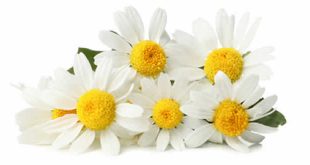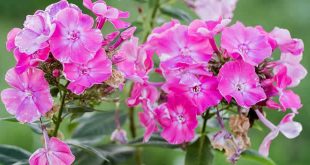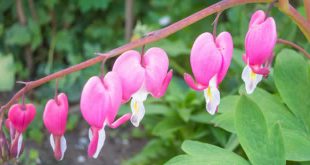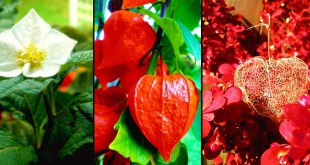Water Hyacinth — The seven species of water hyacinths comprise the genus Eichhornia of free-floating perennial aquatic plants native to tropical South America. With broad, thick and glossy ovate leaves, water hyacinths may rise some 1 metre in height. The leaves are 10-20 cm across, supported above the water surface by long, spongy and bulbous stalks. The feathery, freely hanging roots are purplish black. An erect stalk supports a single spike of 8-15 conspicuously attractive flowers, mostly lavender to pinkish in colour with six petals. When not in bloom, water hyacinth may be mistaken for frog’s-bit (Limnobium spongia).
One of the fastest growing plants known, water hyacinth reproduces primarily by way of runners or stolons, eventually forming daughter plants. They may also reproduce via seeds. The common water hyacinth (Eichhornia crassipes) is a vigorous grower known to double its population in two weeks.
Water hyacinths have been widely introduced throughout North America, Asia, Australia and Africa. For example, they can be found in large water areas in Louisiana, or in the Kerala Backwaters in India. In many areas they, particularly E. crassipes, are important and pernicious invasive species. First introduced to North America in 1884, an estimated 50 kilograms per square metre of hyacinth once choked Florida’s waterways, although the problem there has since been mitigated. When not controlled, water hyacinth will cover lakes and ponds entirely; this dramatically impacts water flow, blocks sunlight from reaching native aquatic plants, and starves the water of oxygen, often leading to fish kills. The plants also create a prime habitat for mosquitos, the classic vectors of disease, and a species of snail known to host a parasitic flatworm which causes schistosomiasis (snail fever). Directly blamed for starving subsistence farmers in Papua New Guinea and Australia, water hyacinth remains a major problem where effective control programmes are not in place.
Water hyacinth often invades water bodies that have already been impacted by human activities. For example, it is a common problem in eutrophied lakes that receive large amounts of nutrients, wich become pollution as they unbalance natural lifecycles, and in artificial reservoirs.
In some areas, uses are being found for the abundant plants, such as for cattle food and in biogas production. Recently, they have also begun to be used in wastewater treatment due to their fast growth and ability to tolerate high levels of pollution.
As chemical and mechanical removal is often too expensive and ineffective, researchers have turned to biological control agents to deal with water hyacinth. The effort began in the 1970s when USDA researchers released three species of weevil known to feed on water hyacinth into the United States, Neochetina bruchi, N. eichhorniae, and the water hyacinth borer Sameodes albiguttalis. Although meeting with limited success, the weevils have since been released in more than 20 other countries. However, the most effective control method remains the control of excessive nutrients and prevention of the spread of this species.
 Kids Portal For Parents India Kids Network
Kids Portal For Parents India Kids Network




